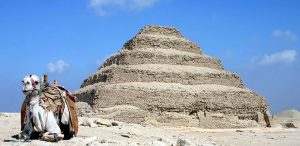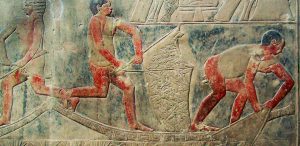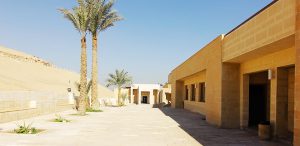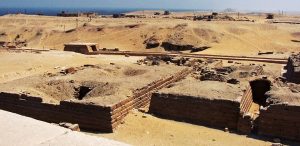+20 2 3762 0904 / +372 5923 9322 /
+44 745 225 4645
Introducción sobre Saqqara
Saqqara es uno de los sitios arqueológicos más ricos de Egipto. Fue necrópolis de la ciudad de Menfis, durante la I Dinastía (siglo XXX a.C.) hasta el período copto (siglo II d.C.). Es decir, más de 3000 años de enterramientos de reyes, nobles y familia real.
Hoy Saqqara es un lugar histórico visitado por miles de turistas, quienes recorren la necrópolis principalmente atraídos por la Pirámide Escalonada del faraón Zóser, aunque también se pueden visitar la Pirámide de Unis y otras tumbas del Reino Antiguo.
Ubicación Geográfica
Saqqara está ubicada a solo 15km de Menfis, en una meseta alta, a unos 30km al suroeste del centro de El Cairo y a 10km al sur de las Pirámides de Guiza. Por lo general, la excursión a Saqqara está acompañada de una visita a Menfis y a las Pirámides de Guiza.
Historia
El primer edificio construido en la necrópolis de Saqqara probablemente sea la Pirámide de Zóser, construida por el famoso Imhotep, el alto sacerdote de Heliópolis.
La Pirámide Escalonada marco un punto importante en la historia del Antiguo Egipto y la construcción de pirámides. Antes del siglo XXVII a.C., las tumbas eran sólo mastabas: una hilera de ladrillos de adobe que cubría el hueco en el suelo donde se enterraba al difunto.
Imhotep tuvo en cuenta esto cuando construyó la pirámide: puso seis hileras de piedra caliza una sobre otra, formando así este magnífico monumento que perdura hasta nuestros días y es uno de los logros arquitectónicos más importantes del Mundo Antiguo.
La primera capa o hilera de la Pirámide Escalonada tenía una forma cuadrada de 63mts de lado y una altura de 8mts. Esto la diferencia de las mastabas anteriores, porque éstas tenían forma rectangular.
Durante la segunda fase de construcción, se aumentó el tamaño de la primera hilera, y cada lado pasó a tener 71mts, con sólo 7mts. de altura. En la tercera fase, cada lado tuvo 80mts; en la cuarta fase 85mts y en la quinta fase pasó a tener 119mts.
Descripción
Hoy la Pirámide de Saqqara tiene una base de 109 mts x 125mts, y 62mts de altura, y sus características originales todavía se preservan bastante bien.
Alrededor de la pirámide hay una muralla de 10mts de alto, considerada también como uno de los logros notables de la arquitectura egipcia.
La entrada a la pirámide y al complejo en sí, se hace a través del templo mortuorio, que consiste de 40 pilares y algunos relieves. La fachada del templo es interesante por su gran tamaño y la excelencia de su construcción.
Pirámide de Unis
Situada al sur de la Pirámide Escalonada, está la pirámide del rey Unis, el último de la V Dinastía. Está decorada con inscripciones conocidas como “Textos de las Pirámides”, donde se describe la vida en el más allá y los rituales que debe realizar el difunto para obtener la vida eterna.
Pirámide de Teti
A pesar de que esta pirámide no está muy bien conservada, la cámara funeraria merece una visita. Allí se encuentra el sarcófago del rey y se pueden observar bellas decoraciones en el techo, así como inscripciones antiguas. Es la única pirámide abierta al público.
Tumba de Mereruka
Es la más impactante de las tumbas del complejo de Saqqara. Consiste en 33 cámaras, y tiene hermosas pinturas y la estatua de su dueño, Mereruka, yerno del rey Teti.
El Serapeum
Esta sección es una de las más distintivas de la necrópolis de Saqqara. El Serapeum era el lugar de entierro de los toros sagrados. Tiene diferentes corredores y pasillos que conducen a un número considerable de sarcófagos grandes hechos de granito, para el dios-toro.
Los antiguos egipcios creían que el toro era la representación del dios Ptah, el dios de la ciudad de Menfis.
A comienzos del siglo XIV se descubrió una momia perfectamente conservada, la cual se encuentra en exhibición en el Museo de la Agricultura de El Cairo.
El Museo de Imhotep
Este museo fue creado en 2006, y lleva el nombre del arquitecto responsable de la construcción de la pieza maestra del complejo de Saqqara: la Pirámide Escalonada de Zóser. El museo consiste de seis salas, donde se pueden apreciar los objetos descubiertos en Saqqara, como estatuas, momias, sarcófagos, que datan de varios períodos de la historia egipcia.
One of the richest archaeological sites in Egypt, Saqqara was the ancient necropolis of Egypt in the period starting from the 1st dynasty in the 30th century BC till the Coptic period in Egypt around the 2nd century AD. This makes more than three thousand years that Saqqara was used to bury the deceased kings, nobles, and royal family in a funerary complex.
When King Menes unified Egypt more than 4000 years ago, he established the first capital of Egypt that was called Memphis. Saqqara was, in fact, the burial site of Memphis in the old kingdom. Today Saqqara is one of the historical sites that welcome hundreds of tourists who spend their vacation in Egypt. Moreover, the step pyramid in Saqqara is considered to be the oldest surviving monument in the whole world.
With the monuments like the step Djoser pyramid, the pyramid of Unas, and some marvelous ancient tombs, almost all travel packages in Egypt include a visit to the Saqqara Egyptian pyramid.
It was common that a burial site, or the city of the dead as being called in ancient Egypt, would be situated near the capital, or the city of the living for ancient Egypt. This is why Saqqara is located only around 15 kilometers away from Memphis. This is the reason mainly why tours to Egypt would include the visit to the Pyramids of Giza together with Saqqara and then Memphis, the tombs for the kings.
Located on a high plateau, Saqqara is located around 30 kilometers to the South West of the center Cairo and around 10 kilometers to the South of the Pyramids of Giza. Many travelers spending enjoyable vacations in Egypt include visiting the historical site of Saqqara with some of the other highlights around it.
Today the Pyramid of Saqqara has a base that is 109 X 125 meters in size and the whole construction is 62 meters in height with all its original features being preserved up till today and this is why many tourists who spend their vacation in Egypt explore the pyramid site during their Cairo tour.

The entrance to the step pyramid today and the whole pyramid complex is from the mortuary temple that consists of 40 notable pillars and some wonderful wall carvings. The façade of the temple is notable as well for its impressive large size and construction excellence.
To the South of the impressive Step Pyramid of Djoser, there is the smaller less elegant pyramid of Unas, the last king just after the fourth dynasty finished. This pyramid is featured with some of the most ancient decorative inscriptions known in history.
Despite the fact that the pyramid of Teti is in ruins now, but a pile of rubbles, the burial chamber is quite interesting and it is worth a visit. This is besides a fascinating well preserved stone tomb of the king, the wonderful celling decorations and some of the most ancient tombs writings that are the only one open for public in Saqqara today.

This is one of the most distinctive sections in the ancient site of Saqqara. The Serapeum was actually the burial site of the sacred bulls. It consists of many corridors and alleys that lead to a considerable number of huge sarcophagi made out of granite for the animal god.
The ancient Egyptian saw that the bull is the representation of the god Ptah, the god of the city of Memphis. One intact tomb was discovered in the beginning of the 19th century and it contained the perfectly preserved mummy of a bull that is now put on display in the Agriculture Museum in Cairo.

The first establishment that might be erected in the Saqqara necropolis is the step pyramid of Djoser. We can never mention the step pyramid and overlook the role Imhotep, the highest priest of Heliopolis, played in its design and its construction.
The Step Pyramid marks an important transitory landmark in 
Imhotep thought of this marvelous idea when he first used limestone to build the pyramid. Moreover, He constructed six Mastaba or layers of limestone on top of each other’s to build this wonderful monument which was considered at that time, and even until today, as one of the most remarkable architectural achievements.
The first layer of the step pyramid had a square shape with each side being 63 meters and a height of 8 meters. This was different than any Mastaba tomb that was constructed in the past as they used to have a rectangle shape. A corridor was also constructed to lead to the king’s burial tomb.
During the second phase of the pyramid construction, the size of the first layer was enlarged that each of its sides became 71 meters with only 7 meters in height while during the third phase of each side of the first layer became around 80 meters, in the fourth phase each side became around 85 meters, and in the fifth phase, it became 119 meters.